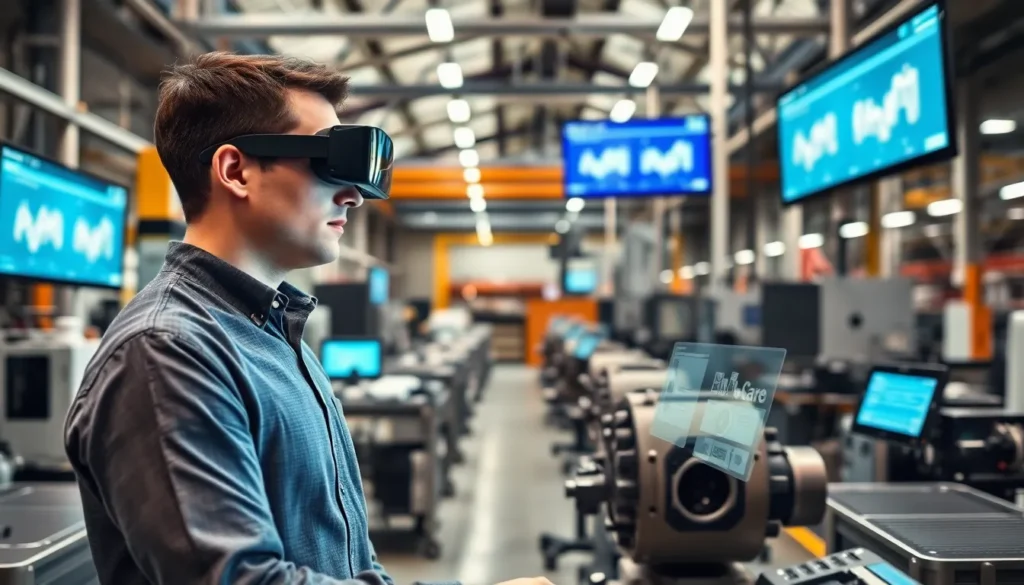Augmented Reality (AR) is like that neat trick your magician friend pulls off, blending the real and virtual worlds so seamlessly that you’re left wondering what’s real and what’s not. It’s not just for gaming anymore, folks. From healthcare to retail, AR is transforming industries in ways we never thought possible. Let’s jump into the intriguing applications of augmented reality that are catching the attention of businesses and consumers alike.
Table of Contents
ToggleImpact On Various Industries

Healthcare Innovations
In the medical field, augmented reality is revolutionizing how professionals diagnose and treat patients. Imagine a surgeon using AR glasses to overlay critical information right onto the patient during an operation. This isn’t a scene from a sci-fi movie: it’s happening now. With tools like the Microsoft HoloLens, doctors can visualize complex data, helping them make better decisions with precision. Also, AR is also being used for medical training, giving students and professionals interactive simulations that mimic real-life scenarios without the high stakes.
Education And Training Enhancements
The classroom is no longer confined to four walls, thanks to AR. Instructors are integrating augmented reality into their lesson plans, transforming traditional learning into a captivating, immersive experience. For instance, history lessons become more engaging when students can explore ancient ruins right from their classroom. Companies are also adopting AR for employee training, allowing new hires to practice in a safe, controlled environment. With AR, learning is not just effective: it’s fun.
Retail And E-Commerce Transformation
Gone are the days of merely browsing products online. Now, consumers can virtually try on clothes or place furniture in their living rooms before making a purchase. Apps like IKEA Place let users visualize how a piece of furniture will fit and look in their home. This capability not only boosts shopper confidence but also reduces return rates. Retailers are capitalizing on this by offering AR experiences that drive engagement and, eventually, sales.
Real Estate And Architecture Advancements
In real estate, augmented reality is changing how properties are showcased. Clients can take virtual tours of properties without ever leaving their homes. Also, architects use AR to visualize design concepts, allowing clients to walk through a 3D model of their future home before it’s built. This technology streamlines communication between stakeholders, ensuring everyone’s on the same page, literally and figuratively.
Entertainment And Gaming Evolution
Who could forget the impact of AR on gaming? With Pokémon GO leading the charge, AR has captivated millions and turned neighborhoods into adventure zones. But it doesn’t stop there: AR is also making waves in movies and live performances, enhancing audience engagement like never before. Imagine watching a concert where the visuals change based on the songs or a movie that interacts with your surroundings, that’s the future of entertainment.
Future Prospects Of Augmented Reality Applications
Looking ahead, the possibilities for augmented reality applications seem limitless. Companies are exploring how to merge AR with AI, leading to smarter and more intuitive experiences. Envision a world where your environment can provide real-time translations, or digital assistants guiding you through complex tasks with ease. Also, as AR hardware becomes more affordable and accessible, more industries are likely to adopt this technology. From tourism, where AR can bring historical sights to life, to agriculture aiding farmers in optimizing crop yields, the horizon for AR applications is as expansive as it is exciting.
Challenges And Considerations In Implementation
While the benefits of augmented reality are compelling, the path to implementation isn’t without challenges. Privacy concerns loom large, especially as AR applications collect vast amounts of data. Users must be assured that their information is secure. Also, the technology can be costly to develop and integrate into existing systems. Businesses also face the hurdle of training staff to use these new tools effectively. Finally, there’s the issue of consumer adaptation. Many users may be hesitant to embrace AR due to a lack of understanding or perceived complexity. Addressing these challenges is crucial for widespread adoption.





